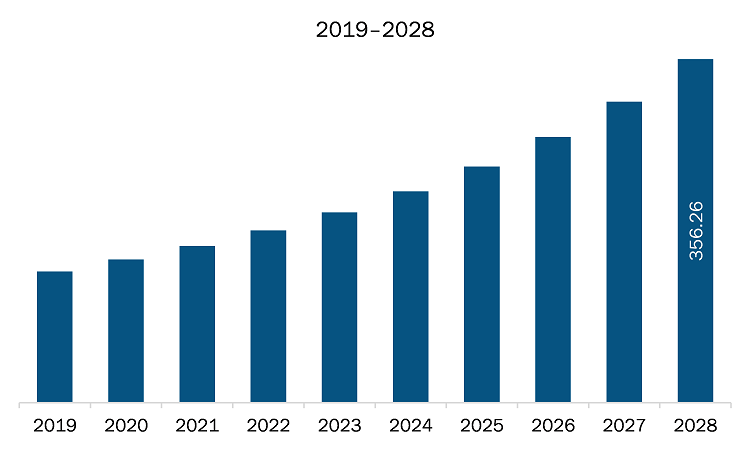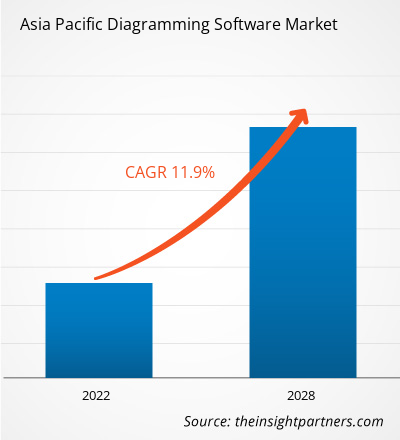The diagramming software market in APAC is expected to grow from US$ 162.61 million in 2021 to US$ 356.26 million by 2028; it is estimated to grow at a CAGR of 11.9% from 2021 to 2028.
China, Japan, and India are major economies in APAC. Rising adoption of cloud-based diagramming software across organizations is the major factor driving the growth of the APAC diagramming software market. Owing to the rise in industrialization and globalization initiatives in several countries, business activities are growing across all industries. Additionally, it has been observed that more than 75% of enterprises are planning to adopt digital transformation to have business recovery out of 2020. The enterprises are looking ahead to adopt cost-effective and collaborative solutions to accomplish their pre-determined digital goals. For instance, penetration of free and cloud-based platforms such as diagramming software is expected to gain high momentum. The cloud-based platform assists teams to track, collaborate, and possibly manage workflows. The diagramming solutions enable the end users to automate the management approval workflow process for business and release complete transparency. For instance, Nulab, Inc. offers Cacoo – a cloud-based online diagramming solution. The solution connects processes and individuals throughout customers, internal departments, suppliers, and vendors to communication workflows and hierarchy in a diagrammatic format. Therefore, diagramming software contributes positively to achieving the various organizational goals such as communication and presentations. By migrating the diagramming solutions on the cloud, the enterprises are experiencing numerous benefits while propelling the speed of diagramming and reducing internal and external costs. This aspect of reducing costs and accelerating diagram approvals is influencing the adoption of cloud-based diagramming solutions across enterprises, thereby driving the APAC market.The COVID-19 pandemic has severely impacted APAC due to wide disease spread. Countries in this region are among the highly populated countries in the world, which leads to a greater risk of infection spread. Many global brands and technology companies are headquartered in APAC. According to the Organization for Economic Co-operation and Development (OECD), the pandemic has adversely affected major economies such as China, India, Australia, and Japan, which are experiencing inflation. The rapid COVID-19 outbreak led to strict lockdowns across the region since the starting of 2020.Though the region experienced a dip in technological investments in the initial stage of the outbreak owing to the standstill of all economic activities, the demand for cloud-based diagramming solutions across enterprises is increasing eventually with the rise in work from home culture across the region. This drive the adoption of diagramming solutions for better communication among teams and collaboration through platforms, such as Zoom and Google Meet. Thus, the diagramming software market is experiencing a positive impact of the pandemic.
- This FREE sample will include data analysis, ranging from market trends to estimates and forecasts.
APAC Diagramming Software Market Segmentation
APAC Diagramming Software Market – By Deployment Type
- Cloud
- On-Premises
APAC Diagramming Software Market – By Enterprise Size
- SMEs
- Large Enterprises
APAC Diagramming Software Market – By Application
- Corporates
- Educational Institutions
- Personal
APAC Diagramming Software Market– By Country
- China
- Japan
- South Korea
- India
- Australia
- Rest of APAC
APAC Diagramming Software Market-Companies Mentioned
- CREATELY (CINERGIX PTY LTD)
- Edrawsoft
- Gliffy (Perforce Software, Inc.)
- Lucid Software Inc
- Microsoft Corporation
- Miro
- Nulab Inc
- SmartDraw, LLC
Asia Pacific Diagramming Software Report Scope
| Report Attribute | Details |
|---|---|
| Market size in 2021 | US$ 162.61 Million |
| Market Size by 2028 | US$ 356.26 Million |
| Global CAGR (2021 - 2028) | 11.9% |
| Historical Data | 2019-2020 |
| Forecast period | 2022-2028 |
| Segments Covered |
By Deployment Type
|
| Regions and Countries Covered | Asia-Pacific
|
| Market leaders and key company profiles |
- Historical Analysis (2 Years), Base Year, Forecast (7 Years) with CAGR
- PEST and SWOT Analysis
- Market Size Value / Volume - Global, Regional, Country
- Industry and Competitive Landscape
- Excel Dataset


- Water Pipeline Leak Detection System Market
- Malaria Treatment Market
- Hydrocephalus Shunts Market
- Microplate Reader Market
- Electronic Health Record Market
- Gas Engine Market
- Lyophilization Services for Biopharmaceuticals Market
- Employment Screening Services Market
- Travel Vaccines Market
- Medical Devices Market

Report Coverage
Revenue forecast, Company Analysis, Industry landscape, Growth factors, and Trends

Segment Covered
This text is related
to segments covered.

Regional Scope
North America, Europe, Asia Pacific, Middle East & Africa, South & Central America

Country Scope
This text is related
to country scope.
Trends and growth analysis reports related to Technology, Media and Telecommunications : READ MORE..
- CREATELY (CINERGIX PTY LTD)
- Edrawsoft
- Gliffy (Perforce Software, Inc.)
- Lucid Software Inc
- Microsoft Corporation
- Miro
- Nulab Inc
- SmartDraw, LLC

 Get Free Sample For
Get Free Sample For